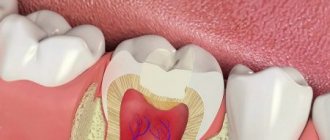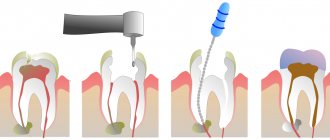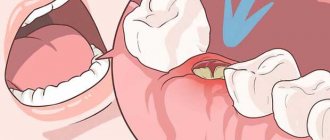Dental treatment is a medical procedure that corrects a smile, corrects imperfections and relieves pain. However, discomfort after dental surgery, in particular after installing a filling, does not go away immediately.
In 90% of cases, mild pain is natural, since the filling affects nerves, canals, and tissues. It takes time for the filling to “take root”. During this period, the pain can be constant, fading or variable, provoked by irritants: hot tea, strong pressure on the gums, etc.
But there are other pains - pathological ones. They require new medical intervention and careful treatment. Let's consider each option in more detail.
Content:
- When is a non-permanent filling indicated?
- Why does a tooth with a temporary filling hurt?
- When to sound the alarm
- What to do if a tooth hurts under a temporary filling
- Preventive measures
Most often, people rush to the dental clinic because of pain.
Naturally, every person hopes that he will return home with a healthy tooth. Unfortunately, this is not always the case. Often in dental practice there are situations when the doctor has to put a temporary filling instead of a permanent one. It is distinguished by its low cost and loose structure. It is loosely held in the carious cavity and quite quickly falls out on its own or decreases in volume. These features are due to the fact that the temporary filling material must be easily removed. The problems it solves:
- protection of the carious “hollow” from the accumulation of food debris and the penetration of pathogenic bacteria;
- preventing premature loss of medication from the “hole”.
Insufficient canal filling
The opposite situation, in which a tooth may hurt after treatment of pulpitis, is insufficient filling of the root canals, the formation of voids at the apex of the root. In this case, often unpleasant sensations do not occur immediately, but as the inflammatory process develops - this can happen either after 1-2 weeks or after a longer period of time.
Here, painful sensations are associated with the proliferation of pathogenic microorganisms in the voids. This process leads to one of the diseases:
- periodontitis - inflammation of the peri-root tissues;
- tooth root apex cyst;
- granuloma.
Depending on the individual characteristics of the body, pain may appear immediately or make itself felt when the cyst or granuloma has reached an impressive size. Its intensity is often low, minor pain is more often observed when biting after treatment of pulpitis, and in the absence of mechanical impact on the tooth there is no discomfort at all.
Why does a tooth with a temporary filling hurt?
Often the temporary filling hurts. Among the main reasons for this problem are:
- Serious damage to dentin tissue. Injuries to dentinal tissues when treating a carious area with a drill cannot be avoided. Dentin has the ability to heal itself, but this does not happen overnight. Soon everything will return to normal - the patient just needs to be patient.
- Overheating of the dentinal zone. It happens if the doctor worked with the drill for too long and did not use water cooling in the process of cleaning the “hole”. It may also be a consequence of the use of faulty medical equipment.
- The filling height is too high. Then, when pressing on the tooth, acute pain appears. You shouldn't tolerate it. The most reasonable thing is to make an appointment with a doctor and ask him to remove the excess material. In general, this reason is rare, since before sending the patient home, a good specialist always makes sure that the material is standing properly and does not take up excessive space.
- Exceeding the prescribed treatment period. The doctor clearly announces when you need to come for a follow-up appointment to remove the stored medicine. But some people ignore such instructions and walk with the material longer. Then there is a destructive effect on the tissues of the unit, aching or acute pain appears. A medicinal composition whose service life has long expired becomes toxic. It disrupts metabolic processes occurring in local tissues. Promotes crown destruction. Cracks form on the surface of the latter.
- Individual intolerance to the prescribed filling composition. Sometimes in dental practice there are allergies to the drugs used. Then, after laying the material, swelling appears. The tooth starts to hurt.
- Partial destruction of the seal. The formed depression may be very small and, quite possibly, the person will not even notice that any changes have occurred to his tooth. Meanwhile, pathogenic organisms will begin to penetrate through the hole that appears into the deep tissues. This will cause inflammation. The unit will begin to react painfully to temperature changes, spicy, salty and sour foods.
It is important to understand what is causing the pain symptoms. The patient cannot do this on his own, since this involves an in-person examination in the dentist’s office. You need to make an appointment with a doctor as soon as possible and undergo the treatment he suggests.
Reason one. Injury
If you were hit in the jaw or fell, after which the symptoms described above appeared, then it is likely that as a result of this incident the pulp, which is a neurovascular bundle, was damaged. As a result of the injury, it became inflamed, swelling formed, and now there is a feeling of compression of the hard tissues that surround it. In this case, the first signal will be itching, only after it does throbbing pain appear.
Also, the tooth can change its color - suddenly acquire a shade from gray to pinkish. The latter signals that serious damage has been sustained and the pulp has begun to die as a result of inflammation.
When to sound the alarm
Is it normal for a tooth with a temporary filling to hurt a lot? No. Mild discomfort is possible, but long-lasting acute pain is a reason to visit the doctor again. However, this should be done as soon as possible. It is especially dangerous if a person’s well-being worsens at night, swelling has formed or a purulent “bump” has appeared - all this may indicate the rapid progression of dangerous complications.
What kind of pain can there be and what problem does it indicate:
- The tooth aches constantly. The state of health after the last visit to the dentist does not worsen, but does not improve either. This is possible if you are allergic to a dental composition, use too high a dose of the drug (intoxication occurred due to an overdose), or use a very low dose of the drug (the infection could not be stopped and it continues to actively progress).
- Discomfort appears only when pressing on the diseased unit. Here one should suspect traumatic damage to the periodontium due to the artificial overestimation of the dental crown.
- Unbearable pain appears even with a slight touch to the tooth. Perhaps a fragment of a medical instrument remains in the canal or acute periodontitis has developed.
- There are attacks of pain. This happens when the purulent form of pulpitis is advanced.
"Age" features
Itchy sensations can occur at any time. This is due to various reasons, depending on whether a child or an adult suffers from unpleasant manifestations. Let's consider the main cases typical for certain categories of patients.
Itching in childhood
This is one of the most common signs of milk eruption. In infancy, babies cry a lot, are capricious, pull various objects into their mouths, and sleep poorly. Parents may notice excessive swelling of the mucous membranes of the oral cavity, a change in color to reddish or even bluish. After a certain period of time, white stripes appear on the fabrics. This means that the incisor is coming to the surface and will soon appear entirely.
Older kids complain about similar things. This means that the first bite is replaced by a permanent one. Moms and dads should not ignore this process; it is important to involve a specialist so that he can observe whether everything is happening correctly. If the slightest deviation from the norm is detected, the doctor prescribes the necessary diagnostic tests and develops treatment tactics.
When does the symptom appear in adolescents?
If the problem affects a person during adolescence, this indicates the development of a pathological process. In this case, you cannot do without a thorough diagnosis and medical examination. Often we are talking about hidden inflammation inside the gums or teeth. The sooner therapy is started, the faster it will be possible to get rid of the problem and avoid various complications.
Itching and scratching are often observed when installing braces. This happens both immediately after installation and as a result of a planned correction of the tension force of the metal arc.
As an adult
Provoking factors in older patients can be anything. More often it is smoking, excessive alcohol consumption and other bad habits, allergies to filling materials and prostheses, crowns. In some cases, the cause may be inflammation of the soft tissues, as well as diseases such as gingivitis, stomatitis, periodontitis, glossitis.
Often, men and women experience neurological disorders that lead to itchy sensations. With mental stress, bruxism (grinding in sleep) sometimes occurs.
When the orthopedic design is not selected correctly, it scratches the gums and tongue. The same applies to the installation of crowns and fillings, which cause discomfort of varying severity.
What to do if a tooth hurts under a temporary filling
The first thing a patient should do is get qualified medical care. Remember: for acute pain, all dentists accept appointments without an appointment. If for some reason a visit to the dentist has to be postponed for one or two days (for example, discomfort occurred on the weekend), you will have to self-medicate. This may include:
- Taking a safe analgesic. It is advisable to consult with your dentist in advance about acceptable medications that reduce pain symptoms. Such drugs should always be selected on an individual basis, as they have a large number of side effects and contraindications.
- Rinsing the mouth with a solution of salt or soda. Decoctions of chamomile and sage have proven themselves well. It is also acceptable to periodically apply an anesthetic dental gel to the gums.
It is possible that after the examination the specialist will say that there is no cause for concern. Then the patient will have to complete the prescribed period, relieving pain with analgesics.
Under no circumstances should you force the process of replacing a temporary filling material with a permanent one. This can lead to serious complications in the future. Then you will have to unseal and carry out treatment from the very beginning.
Instrument breakage in the root canal
After treatment of pulpitis, the tooth may also hurt due to a broken instrument. Part of it remains in the root canal, and unpleasant sensations occur immediately or a few days after the visit to the dental office.
The nature of the pain may vary depending on the size of the fragment and other conditions.
It is worth noting that this complication is quite rare. This is explained by the fact that a good dental clinic uses modern, high-quality instruments from reliable manufacturers that are sufficiently durable. In addition, the rules for their use must be strictly observed, including multiplicity, force during exposure, etc. And finally, the doctor will notice the presence of a foreign body in the tooth on a control image, which he will prescribe after treatment.
Preventive measures
In order for the process of preparing for the main treatment to proceed without unpleasant surprises and dangerous complications, you must follow simple rules:
- Try not to put stress on the sealed unit. This means that you should chew food from the “healthy side”. Under no circumstances should you chew on foreign objects. Also, intensive rinsing should not be done unless prescribed by a doctor.
- Maintain good oral hygiene. It is necessary to carry out hygiene measures in the morning and evening. Inflamed areas of the gums can be treated with a brush with soft bristles.
- Check the temporary filling for cracks and chips. If they appear, a re-sealing should be carried out. Otherwise, by the time the permanent material is installed, there may be nothing left of the dental crown - it will collapse under the aggressive influence of pathogens.
Watch your tooth filled with a temporary filling carefully. Then you will avoid many problems.
One of the root canals was not processed
This is one of the rarest complications, since before starting endodontic treatment the doctor will definitely prescribe an x-ray diagnosis. It allows you to reliably determine the number of channels and evaluate their structure. But there are cases of abnormal location of root canals or their extremely small sizes, which makes them unnoticed in the image.
This leads to the following situation: the doctor removes the pulp in each canal, but one remains unattended - the inflamed pulp continues to hurt, and pathogenic bacteria continue to multiply. Such pain is difficult to confuse with other complications - the patient simply does not receive relief after treatment, and the pain characteristic of pulpitis itself remains. The sensations are pulsating in nature, the pain intensifies when eating, exposure to temperature on the tooth, and becomes unbearable at night.
The same symptoms can be observed with incomplete removal of the pulp in the diagnosed canal. In both cases, other symptoms may be observed:
- headache, sensations “radiate” to the ear, temple - depending on the specific tooth;
- increased body temperature;
- symptoms of general malaise.
Most complications are related to the complexity of the canal structure, and the following is no exception.
Root perforation
Perforation is the creation of an artificial root hole. As a rule, in this case, the pain is sharp, unbearable and makes itself felt immediately after the anesthetic stops working. This can happen during instrumental processing of canals - preparing them for filling.
As in most other cases, the structure of the root system plays an important role here. Narrow, curved canals are a common cause of perforation. In this case, the tool does not move along the canal, but into the root wall.
If a tooth hurts for this reason after treatment of pulpitis, the symptom may be accompanied by bleeding. In addition, some patients report pain even with current anesthesia - subjectively it is perceived as the feeling of an injection into the gums. If the tooth was filled after perforation, the filling material may leak beyond the root. Severe pain persists for up to 3 weeks, and the main complication of this phenomenon is the inflammatory process.
Acute periodontitis
If a patient is diagnosed with acute periodontitis, he will have to visit the dentist more than once. During the first appointment, the doctor must examine the problem, take an x-ray and open the chamber of the tooth. It is also necessary to clean the channels inside it using antiseptic solutions. At home, the patient is required to rinse to remove all contaminants from the canals and dental chamber.
When you visit the doctor again, the canals are washed again, after which they are filled with medicine. And at this moment they put a filling. If you need a temporary filling, you can buy it at the pharmacy, but it is better to trust the doctor’s choice. When all the pain goes away, he can perform this procedure in your mouth.
Remember that a temporary filling is an important detail on which the entire treatment depends. Therefore, the doctor must select and install it himself.









